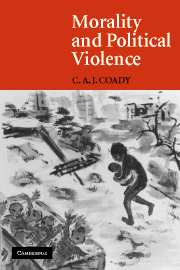Book contents
- Frontmatter
- Contents
- Preface
- Morality and Political Violence
- 1 Staring at Armageddon
- 2 The Idea of Violence
- 3 Violence and Justice
- 4 Aggression, Defence, and Just Cause
- 5 Justice with Prudence
- 6 The Right Way to Fight
- 7 The Problem of Collateral Damage
- 8 The Morality of Terrorism
- 9 The Immunities of Combatants
- 10 Morality and the Mercenary Warrior
- 11 Objecting Morally
- 12 Weapons of Mass Destruction
- 13 The Ideal of Peace
- 14 The Issue of Stringency
- Bibliography
- Index
4 - Aggression, Defence, and Just Cause
Published online by Cambridge University Press: 05 June 2012
- Frontmatter
- Contents
- Preface
- Morality and Political Violence
- 1 Staring at Armageddon
- 2 The Idea of Violence
- 3 Violence and Justice
- 4 Aggression, Defence, and Just Cause
- 5 Justice with Prudence
- 6 The Right Way to Fight
- 7 The Problem of Collateral Damage
- 8 The Morality of Terrorism
- 9 The Immunities of Combatants
- 10 Morality and the Mercenary Warrior
- 11 Objecting Morally
- 12 Weapons of Mass Destruction
- 13 The Ideal of Peace
- 14 The Issue of Stringency
- Bibliography
- Index
Summary
Every violation of the territorial integrity or political sovereignty of an independent state is called aggression. It is as if we were to brand as murder all attacks on a man's person, all attempts to coerce him, all invasions of his home. … All aggressive acts have one thing in common: they justify forceful resistance, and force cannot be used between nations, as it often can between persons, without putting life itself at risk.
Michael WalzerHow then should we understand “aggression”? The UN General Assembly has defined “aggression” as follows: “Aggression is the use of armed force by a State against the sovereignty, territorial integrity or political independence of another State or in any other manner inconsistent with the Charter of the United Nations.” This is a definition that Michael Walzer makes his own, and we should turn to his discussion as he is the author who has probably given the most cogent account of how the concept of aggression may be made central to a just war theory that licences some wars of defence against aggression under the heading of the JAB. As explained earlier, Walzer uses “the domestic analogy” to argue that war comes into its own, morally speaking, when a state exercises its right of self-defence against an attacking power. This right it gains, in his view, from the way legitimate political power is rooted in communal life.
- Type
- Chapter
- Information
- Morality and Political Violence , pp. 68 - 87Publisher: Cambridge University PressPrint publication year: 2007



